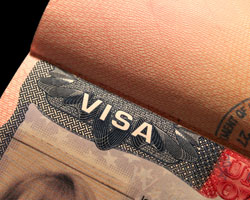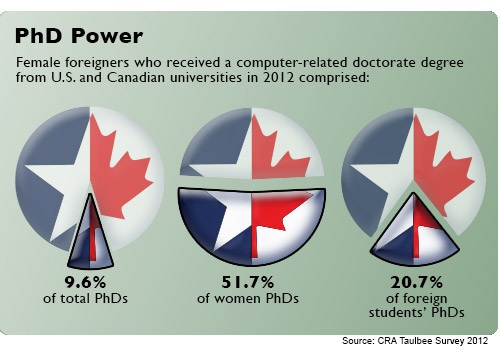Immigration reform proposals are circulating at a furious pace on Capital Hill, but it's unlikely they will lead to a sea change in a rarely thought of area of the guest worker debate: The number of women in IT who work in this country under an H-1B visa.  Even though the percentage of women in IT is higher in many of the home countries of H-1B workers, currently, the vast majority of IT H-1Bs are men. And there's nothing in the bill now making its way through the Senate that aims to realign the ratio of women-to-men guest workers to align more closely with that of the domestic workforce.
Even though the percentage of women in IT is higher in many of the home countries of H-1B workers, currently, the vast majority of IT H-1Bs are men. And there's nothing in the bill now making its way through the Senate that aims to realign the ratio of women-to-men guest workers to align more closely with that of the domestic workforce.
Diversity by the Numbers
American women comprised a mere 25.6 percent of the 3.81 million computer and mathematical workers in the U.S. last year, according to the Bureau of Labor Statistics. Part of the reason is a small labor pool of women engineers coming out of U.S. colleges and universities. For example, only 12.9 percent of bachelor's degrees awarded in computer science during 2012 went to women. In engineering, the number was 10.6 percent. (These percentages are drawn from U.S. universities where doctorate degrees are available, according to the Computing Research Association's Taulbee Survey.) In India -- which supplies the largest number of H-1B technology workers -- far more women earn computer science and engineering degrees, but fewer are hired to work in the U.S. In 2003, a whopping 55 percent of computer science bachelor's degrees and 32 percent of engineering degrees were awarded to women in India, according to a research report, Computing Self-Efficacy among Women in India, by University of New Mexico professor Roli Varma, who specializes in science and technology policy. Within the U.S., 20.7 percent of all foreign students earning a computer-related doctorate are women. Often, U.S. employers from Microsoft to Intel hire computer science and engineering graduates directly out of college.  While hard figures are difficult to come by on the number of H-1B visas awarded to women, some estimates put the number at just 15 percent, says Karen Panetta, Vice President of Communications and Public Awareness for IEEE and an Electrical and Computer Engineering Professor at Tufts University.
While hard figures are difficult to come by on the number of H-1B visas awarded to women, some estimates put the number at just 15 percent, says Karen Panetta, Vice President of Communications and Public Awareness for IEEE and an Electrical and Computer Engineering Professor at Tufts University.
Discrimination Against H-1B Women?
"The demographic composition of Indian engineers coming to the United States under H-1B visa program shows that they are mostly men. This suggests H-1B visa tends to discriminate against women engineers," Varma said in an interview with Dice News. She added: "The pool of women engineers to draw from in India is huge. U.S. companies have opportunities to hire qualified women engineers who will be willing to come to the United States. But, the irony is that women engineers are not being hired." The Special Report:
- Women in IT Face Down Stereotypes and Bias
- Schools Push for Women Computer Scientists
- H-1B Women Few and Far Between
- Interview: Lyla Perrodin, CIO, MRIGlobal
- The Disappearing Women of IT
Panetta says while she doesn't believe U.S. companies are intentionally discriminating against female H-1Bs, she wouldn't be surprised to find companies that are largely comprised of H-1B workers have an inclination not to hire a woman because of cultural differences. Varma agrees. There seems to be a perception among Indian executives that women are likely to move upon marriage, will be missing work due to pregnancy, child birth and being the primary caretakers of small children; may not be able to travel on job related matters, and will likely be hesitant to work with male colleagues in group projects," she says. "Very few executives think that women engineers are less capable of the work compared with male engineers." Another issue that may impact the number of female H-1Bs is their marital status. U.S. immigration laws allow an H-1B visa holder to work, but prohibits spouses from doing so unless they can get a separate visa. In other parts of the world, such restrictions don't exist. One potential solution to drive the hiring of more women H-1Bs is to adopt a similar policy for equal opportunity as U.S companies, Panetta says. "HR departments are usually actively looking for diversity and have signs to encourage women and under-represented people to apply," notes Panetta. She added that companies should ask any outsourcing business they use to employ the same policies to ensure a diverse labor pool.


